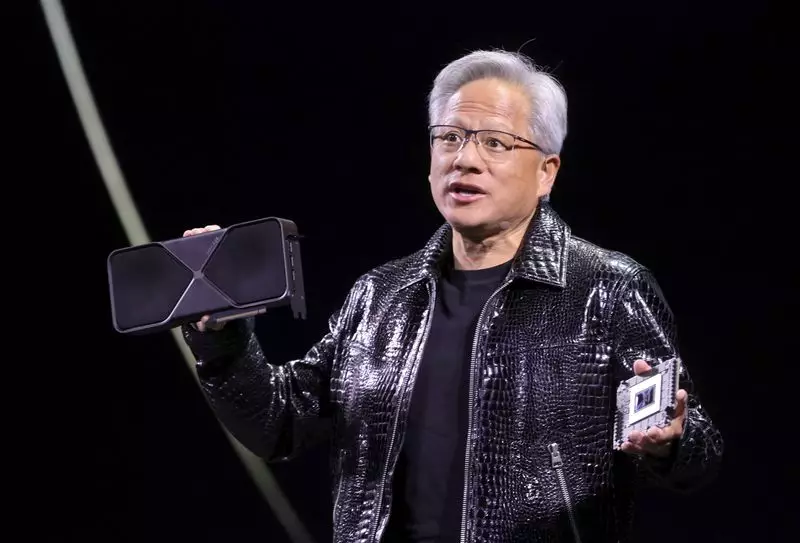The annual CES (Consumer Electronics Show) has proven time and again to be a hotbed of technological advancement, with industry leaders unveiling cutting-edge products and groundbreaking ideas. At CES 2025, Nvidia, a titan in the tech sector, showcased its ambitious plans for the future, providing a glimpse into innovations that could transform both the gaming landscape and the world of artificial intelligence. With the launch of new products aimed at various sectors, from consumer electronics to automotive technology, Nvidia is cementing its position not just as a chip manufacturer, but as an enabler of AI-driven solutions.
One of the standout introductions at the event was Nvidia’s Cosmos foundation models, which promise to redefine how robots and self-driving vehicles are trained. By utilizing synthetic data, these models can generate hyper-realistic video scenarios that adhere to the laws of physics, thus allowing robots and cars to learn in a simulated yet lifelike environment. This innovative approach substantially reduces the costs associated with traditional data collection methods, which often require exhaustive real-world testing and the potential dangers that accompany it.
This capability is particularly groundbreaking because it mirrors the successes of large language models, which have significantly advanced interaction capabilities in chatbots and virtual assistants. Nvidia’s CEO, Jensen Huang, expressed optimism that Cosmos could similarly enhance robotic training processes, drawing a parallel to Meta Platforms’ Llama 3 language model’s impact on enterprise AI. However, analysts remain cautious about the scalability and reliability of this initiative, suggesting that the challenge lies in its practical implementation, raising questions about whether this synthetic approach can deliver results in traditional business models.
In parallel with its AI advancements, Nvidia revealed the RTX 50 gaming chip series, designed to elevate the gaming experience to cinematic levels. This series incorporates the company’s cutting-edge Blackwell AI technology, enabling developers to create more immersive visual experiences. Innovations in shading techniques will allow for greater realism, evident in the organic imperfections that can now be included in digital renderings, such as fingerprints or minute surface details on objects.
The anticipated price range for these new gaming chips, spanning from $549 to $1,999, hints at Nvidia’s strategy to cater to a wide spectrum of gamers, from casual players to enthusiasts willing to invest more for premium experiences. The scheduled release of these chips, starting with high-end models at the end of January, positions Nvidia well to capitalize on the imminent surge in gaming demand in the early months of the year, bolstered by ongoing advancements in graphics fidelity that gamers highly appreciate.
Nvidia’s foray into desktop computing with Project DIGITS, targeted explicitly at software developers, is another pivotal development. This desktop computer will feature Nvidia’s industry-leading chip technology, facilitating streamlined and rapid testing of AI systems. While the $3,000 price point may limit its appeal to hobbyists or casual users, the product is tailored for those deeply engaged in programming and AI development. With a unique operating system built on Linux and collaboration with MediaTek for processing capabilities, Nvidia’s desktop system represents a significant investment in enhancing the developer’s toolkit.
Such products reflect the growing need for powerful computing solutions in AI research and development. As businesses increasingly pivot towards AI-integrated systems, the demand for effective programming environments becomes imperative, and Project DIGITS positions Nvidia to meet this demand directly.
In the realm of the automotive industry, Nvidia is not slowing down. The company affirmed its partnership with Toyota Motor Corporation, which plans to implement Nvidia’s Orin chip and the associated automotive operating system across various vehicle models aimed at bolstering advanced driver-assistance systems. This collaboration highlights an essential trend: the increasing convergence of AI and automotive technology, as companies seek to enhance safety features and user experiences. Huang’s expectations of $5 billion in revenue from automotive technologies in fiscal 2026 underscores the importance Nvidia places on this sector.
As automakers continue to embrace AI to refine their offerings, Nvidia will undoubtedly remain at the forefront, shaping the future of transportation through technology.
Nvidia’s bold announcements at CES 2025 set the stage for a transformative year ahead, characterized by advancements in artificial intelligence, gaming, and automotive technology. As the company continues to deploy synthetic training models, enhance gaming experiences, and forge strategic partnerships, it aims to lead the charge in a rapidly evolving tech landscape. While there are inevitable challenges related to reliability and market acceptance, Nvidia’s innovative spirit and commitment to enhancing user experiences ensure its continued relevance in an increasingly competitive industry. With its market valuation soaring to record highs, all eyes will be on Nvidia as it endeavors to shape its legacy in the tech world.

